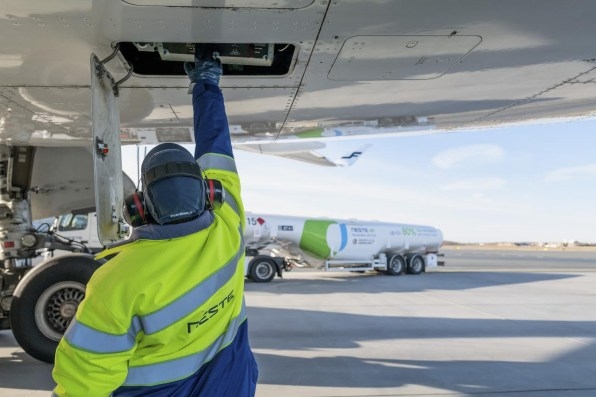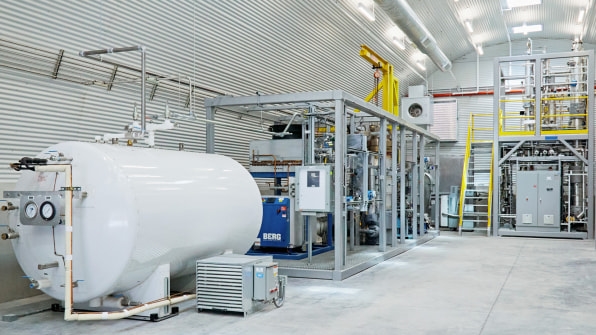Is sustainable aviation fuel actually sustainable?
For the past seven months, a large new factory next to a landfill outside Reno, Nevada, has been turning trash into synthetic crude oil that can be used to make jet fuel. In a plant in Brooklyn, a startup is turning CO2 into jet fuel. Another company just broke ground on a large-scale factory doing the same thing in Moses Lake, Washington. And some airplanes are already flying on fuel made in part from used cooking oil.
The airline industry calls it sustainable aviation fuel (SAF), and it’s relying on it to meet climate goals. But how much SAF actually helps the environment depends on how it’s made—in some cases, an alternative fuel could be responsible for more emissions than the conventional version. Yet if it’s done right, it could shrink emissions by 90% or more.
Will the industry shift to more sustainable methods? And can SAF scale up fast enough to tackle the enormous carbon footprint from airplanes?
While small battery-electric planes might soon be making regional flights, batteries aren’t feasible for larger jets or longer distances. Hydrogen-electric planes, another alternative, are still in development and would require new infrastructure at airports. Sustainable aviation fuel, on the other hand, “doesn’t require major changes to existing aircraft or aircraft technologies,” says Eric O’Rear, a senior analyst at the Rhodium Group, a think tank that studies the sector. That’s especially important, because planes can be in use as long as 30 years, and decarbonization needs to begin now. Current regulations limit the use of SAF to a 50% blend, though with more testing and some changes, it’s expected to eventually be used on its own.
The first sustainable aviation fuel being utilized comes from a low-tech source: used cooking oil. Neste, a Finnish company, refines oil collected from dumpsters behind tens of thousands of restaurants and hotels into fuel. Customers include United Airlines, which is using the biofuel at airports in San Francisco and Amsterdam. For restaurants, which previously had to pay to have waste oil hauled off to landfills, selling it is a way to make a little extra money. Neste, which also uses waste animal fat to make its fuel, says the approach can cut emissions by 80%.

The company has a production capacity of 365 million gallons of fuel per year, and that will jump to 750 million gallons by the end of 2026. But there are limits on the supply of used cooking oil; there isn’t enough available to replace the billions of gallons of fuel that airlines need. “It’s just not scalable,” says Nik Pavlenko, a fuels researcher at the International Council on Clean Transportation. Neste is studying other feedstocks, including algae and forestry waste, to develop alternatives.
For now SAF is the main option for airlines—but because they want so much of it, there’s a risk of less-sustainable options being passed off as used cooking oil in the supply chain. In the U.K., where most waste oil for fuel was imported from Asia last year, there’s concern that some of it is actually palm oil, grown on plantations that could be responsible for deforestation. In 2020, one analysis found that Malaysia had exported more “used” cooking oil than the country had collected.
It’s hard to test and verify the source of the oil. Sellers “can contaminate virgin palm oil with a small bit of used oil and make a claim that it’s just been mildly used,” Pavlenko says. He suggests that governments set limits for sale based on how much used cooking oil can reasonably be produced in the food industry.
Jet fuel can also be made from crops like sugarcane or corn that are converted to ethanol. When these biofuels burn, the emissions are considered carbon-neutral, since the plants took up the same amount of carbon when they were growing (unlike fossil fuels, which emit carbon that plants absorbed millions of years ago and would have otherwise stayed underground). But agriculture also has a large carbon footprint. And more demand for biofuels from crops can mean that farms have to expand to have enough land for food, potentially leading to more deforestation.
If biofuel is made from palm oil, the total life cycle emissions could potentially be higher than if it had been made from petroleum. One Brazilian company plans to produce tens of millions of gallons of palm-oil-based jet fuel by 2025; Indonesia’s state energy company is also testing this type of fuel.
By-products from farming can also be used to make jet fuel. But some plant-oil by-products that are sold as “waste” to make biofuels might have otherwise been used in other industries; residue from palm oil production, for example, is typically used in livestock feed or chemical production. If biofuels consume some of that supply, palm production will likely have to expand to keep up.
Jet fuel made from trash can pose other challenges. Fulcrum BioEnergy, which has a new trash-to-fuel plant near Reno and another planned in Gary, Indiana, has faced criticism about the air pollution that could be created from “gasifying” garbage. The process also uses large amounts of energy, experts say, though Fulcrum declined to comment on its energy use. Some of the waste is plastic, which might otherwise have stored carbon if it was left sitting in a landfill. (Obviously, it’s also not great to have plastic in landfills—but it’s also relatively inert there since it takes so long to break down.)
“These kinds of facilities often come into communities where they think people aren’t paying attention,” says Valerie Denney, a member of a community group called Gary Advocates for Responsible Development. With its long industrial history the city of Gary, Indiana, is heavily polluted.
“We feel that new businesses coming in have to be held to a high standard,” Denney says. “Gary can’t just continue to be a place where, ‘Hey, it doesn’t really matter what you want to do, as long as you bring a few jobs.’” The group is challenging an air permit issued to the Fulcrum project by the state, and says that Fulcrum has refused to share details about how it is controlling the pollution that could come from processing trash, especially plastic.
The most sustainable way to make SAF might be to use CO2 as a feedstock, though it has to be used in the right way—and the process requires a lot of energy. If someone uses energy from the grid now, depending on the current mix of renewables and fossil-based sources, the carbon footprint of the total process could be worse than from conventional petroleum-based jet fuel. With renewable energy, though, the carbon footprint can drop more than 90%.
“It has the lowest carbon pathway for sustainable aviation fuel,” says Nicholas Flanders, CEO and cofounder of Twelve. The startup just broke ground on a new commercial-scale facility that will make jet fuel using CO2, water, and renewable electricity and plans to begin supplying fuel for commercial flights in 2024. The process uses very little land. Air Company, a Brooklyn-based startup that’s making CO2-based jet fuel for the Department of Defense and airlines such as Virgin Atlantic, also expects to see its fuel used on flights within a few years.

This type of fuel, also known as e-fuel or “power to liquids” fuel, is among the most expensive now, says ICCT’s Pavlenko. But it’s low-carbon and scalable. When it scales up, Twelve’s CO2-based fuel will be cost-competitive with fossil fuels, Flanders says. The startup’s partners, including Alaska Airlines and Microsoft, are helping it scale more quickly. Incentives from individual states and from the Inflation Reduction Act are also helping.
More support is needed, says Diana Birkett Rakow, senior VP of public affairs and sustainability at Alaska Airlines. “The biggest challenge to getting SAF is that it is not currently available at the scope, scale, or cost needed to reach our or our industry’s long-term goals,” she says. “There has been a lot of progress in public policy, science and innovation, demand signals, and production commitments. However, we need to ensure that public policy incentives are durable and long-term enough to sufficiently reduce risk and enable private capital investment.”
Airlines like Alaska are still pursuing multiple types of sustainable aviation fuel. “We need all types of SAF for the future, so it would be impractical and unproductive to pick one path,” Rakow says.
Still, all fuels are not created equal. To ensure that airlines make the most sustainable choices, Pavlenko suggests new policies be put in place with “a really clear and transparent set of guidelines” for sustainable aviation fuel. And he argues that the sector could use a different name.
“I think alternative jet fuel is a much better term,” he says. “Because ‘sustainable aviation fuel’ implies that it’s better than fossil fuel, but with so many different factors to take into account, and the reality that some pathways are higher polluting than fossil fuels, I feel like the term sustainable aviation fuel is kind of misleading and inaccurate.”
(52)



